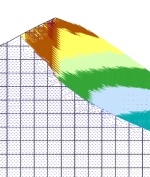 |
Welcome to the websites of Martin Mergili |

BOKU 872.006 UE2 SS2019 2018 2017 2016
Martin Mergili and Christian Zangerl
In engineering geology, computer models are often employed to analyze or to predict the stability of a given slope, or the propagation of landslide processes. Computer models may assist in assessing the current state and in anticipating the occurrence and characteristics of possible future processes. Model results may represent a basis for risk management. This course introduced to the key aspects of computer modelling in engineering geology, with a strong focus on landslide processes.
The course largely followed a concept of learning by doing. The various aspects of modelling were elaborated by introducing step-by-step solutions of selected real-world examples. Even though the course was coupled to specific software, it introduced general skills which could be applied with various tools. It also attempted to convey a feeling for which methods are appropriate for which types of tasks. At the end of the course the participants
- knew some relevant software packages for modelling of mass movements and their scope of application;
- were able to apply computer models in an independent and responsible way;
- knew about the possibilities to develop their own model applications;
- were able to design simple model applications by themselves;
- were able to critically evaluate model results.
Some basic geotechnical knowledge and computational skills were expected from the participants.